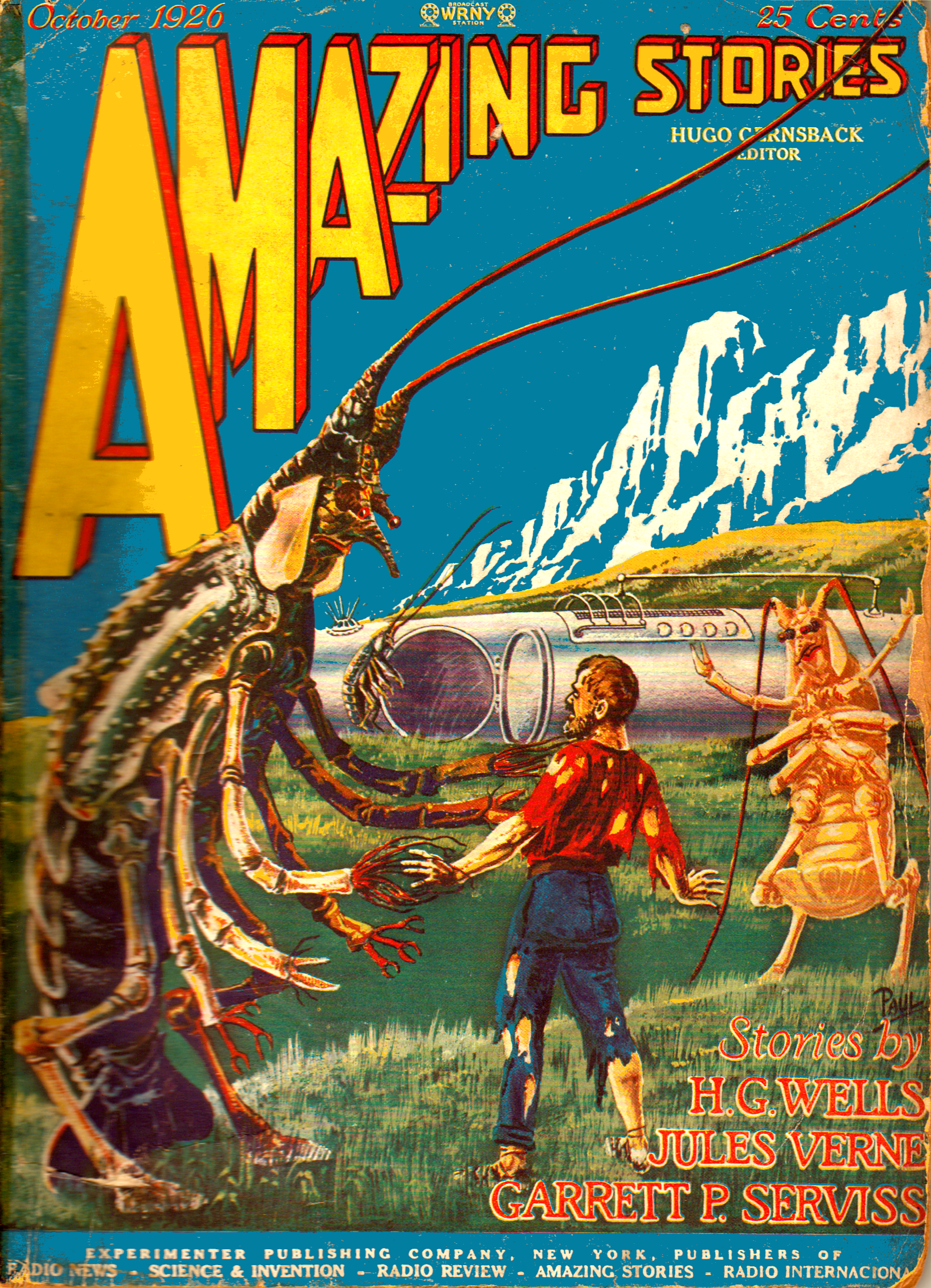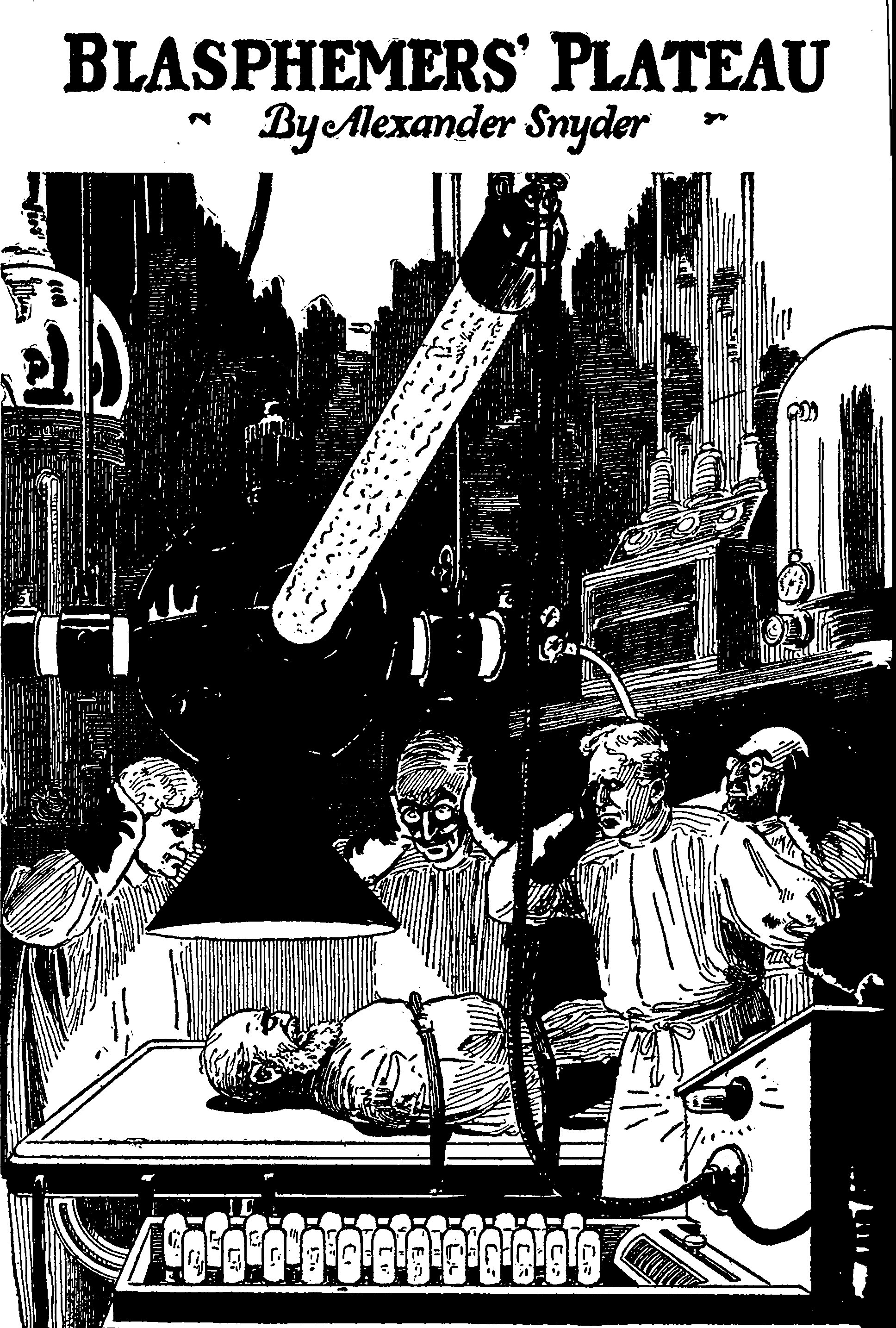I mentioned the joy of holding a 1920/30s issue of Amazing Stories in one’s hands. Do you wonder at the magazine’s reputation? What was so great about Amazing?
Let’s ask a nine-year-old boy.
It’s October 1926. The boy is walking down a sidewalk in Los Angeles. He approaches a newsstand. Suddenly he stops dead in awe. One magazine cover in particular has grabbed his attention, an ‘impossible’ cover depicting a man in ragged clothing recoiling at the touch of a biped lobster taller than himself, beyond them a spaceship resting at the foot of jagged cliffs.
 Forrest J Ackerman has just discovered ‘scientifiction’ in issue #7 of Amazing Stories Magazine. It changes his life. By the late 1930s and early 1940s he becomes quite literally the number one fan (voted as such) in world-wide fandom, and in the 1960s the first and longest-serving editor of Famous Monsters of Filmland Magazine. Not to mention the generous host of weekend tours of his ‘Ackermansion’ with its phenomenal collection of SF memorabilia. All brought about by a chance encounter at a newsstand.
Forrest J Ackerman has just discovered ‘scientifiction’ in issue #7 of Amazing Stories Magazine. It changes his life. By the late 1930s and early 1940s he becomes quite literally the number one fan (voted as such) in world-wide fandom, and in the 1960s the first and longest-serving editor of Famous Monsters of Filmland Magazine. Not to mention the generous host of weekend tours of his ‘Ackermansion’ with its phenomenal collection of SF memorabilia. All brought about by a chance encounter at a newsstand.
Forry later claimed the Magazine cover ‘spoke’ to him, saying “Take me home, little boy, you will love me!”
What else urged him to buy the issue? The impressive size for one thing, at 8.5 by 11 inches it was larger than most pulp zines. Seemed bulkier too, because the individual pages were thicker, made from cheap low-grade pulp below industry average. That the pages were numbered 579-672 spoke of continuity and permanence. Best of all was the price, 25 cents. That made it the most expensive adventure pulp zine on the stand. At that price it just had to be good!
 Inside the boy finds the Zine’s motto “Extravagant Fiction Today – Cold Fact Tomorrow” atop an editorial titled “Imagination And Reality” in which editor Hugo Gernsback offers his trademark theory that conceiving an idea is the next best thing to inventing the technology to make the idea reality. Well, maybe.
Inside the boy finds the Zine’s motto “Extravagant Fiction Today – Cold Fact Tomorrow” atop an editorial titled “Imagination And Reality” in which editor Hugo Gernsback offers his trademark theory that conceiving an idea is the next best thing to inventing the technology to make the idea reality. Well, maybe.
The cover story comes first, “Beyond the Pole” by A. Hyatt Verill. The ‘A’ stands for Alpheus, who was a naturalist and an explorer noted for nearly 100 books of greatly exaggerated non-fiction accounts of his ‘expeditions’ in South America. Occasionally he wrote fiction, including nine serialized stories for Amazing.
What did Gernsback think of “Beyond the Pole?” Quite a lot:
Here is one of the most gripping stories that it has ever been our good fortune to read. At the same time, it is one of the best scientifiction works of the modern school that we have lately seen. It is easily the best scientifiction story of this year.”
Gernsback is being a tad generous. The story involves Frank Bishop who, shipwrecked in Antarctica, finds a lost world inside an extinct volcano wherein lives an intelligent race of lobster people. Turns out the ‘spaceship’ on the cover is actually a sort of flying runabout the Lobsters use.
Methinks Alpheus was influenced by Lovecraft, in that much described turns out to be indescribable:
Indeed, there are many things in this strange land which I am at a loss to describe in such a way that those who have not seen or experienced them can understand my meaning. Colors existed which were quite different from anything I had ever seen; there were sounds totally new to my ears and tastes that no words can describe.”
Nevertheless we learn the Lobsters communicate via telepathy, draw sustenance directly from the soil and air without wasting time growing plants for food, make everything out of metallic sulphur, and produce atomic power by exposing said metal to radioactive pitchblende. Bishop finds the latter very pleasant.
“…I felt no ill effects. Rather, it gave me a pleasant tingling sensation which left me exhilarated for several days thereafter.”
Heady stuff to a nine-year-old mind. Fantastic stuff. To be concluded next issue? Of course the boy would haunt the newsstand till it came out! Had to have it!
 The second story in issue #7 is the concluding episode of “The Columbus of Space” by Garrett P. Serviss, the author of numerous SF stories, including an unofficial sequel to Wells’ “War of the Worlds” titled “Edison’s Conquest of Mars” in which the intrepid inventor develops anti-gravity engines and disintegrating ray guns. This story, however, is about a trip to Venus.
The second story in issue #7 is the concluding episode of “The Columbus of Space” by Garrett P. Serviss, the author of numerous SF stories, including an unofficial sequel to Wells’ “War of the Worlds” titled “Edison’s Conquest of Mars” in which the intrepid inventor develops anti-gravity engines and disintegrating ray guns. This story, however, is about a trip to Venus.
Turns out a certain Edmond Stonewall figures out how to generate atomic power for a spaceship. He takes a couple of friends, neglecting to tell them where they are going, to the dark side of Venus which is inhabited by ape-like cave dwellers. So naturally they slip around to the day side where dwell a race of superior beings (communicating by telepathy of course) who promptly offer Edmond A) a beautiful woman named Ala, and B) death.
From a nine-year-old boy’s point of view the story is entirely too mushy, the plot revolving around competition for Ala. On the plus side, there are attacks by giant bats and a giant spider, and at the end the lovers burn to death in a palace conflagration. Not so mushy that. A bit surprising actually.
And then there’s the occasional rift in the clouds which allows intense sunlight to strike the surface of Venus and annoy everybody into fits of paranoia and suspicion. A nifty concept. A precursor to Asimov’s “Nightfall,” only with the revelation of daylight rather than a star-studded night sky.
Things pick up with the conclusion of “The Purchase of the North Pole” by Jules Verne, and the first part of H.G. Wells’ “The Island of Dr. Moreau.” Can’t go wrong with those two, especially since the works were in public domain and Gernsback didn’t have to pay them. Padding the magazine with classic works of SF eventually built the reader base to the point where Gernsback could afford to stock the zine entirely with original fiction.
 The Purchase of the North Pole” is a bit dry, but “The Island of Dr. Moreau” is mind-bogglingly creepy and frightening, something of a revelation to a nine-year-old boy I’m sure.
The Purchase of the North Pole” is a bit dry, but “The Island of Dr. Moreau” is mind-bogglingly creepy and frightening, something of a revelation to a nine-year-old boy I’m sure.
We all remember the chanting of the law by the beast men in the Charles Laughton film. It is more elaborate in the book:
Not to claw the bark of trees; that is the law. Are we not men?”
Not to chase other men; that is the law. Are we not men?”
And so on. Freaks me out even now. Wonderfully terrifying imagination Wells possessed.
 The last story is “Blasphemer’s Plateau” by Alexander Snyder, about whom I know nothing except that he was a “new writer” to Gernsback (possibly WAS Gernsback). It’s all of a piece, the only non-serialized story in the issue.
The last story is “Blasphemer’s Plateau” by Alexander Snyder, about whom I know nothing except that he was a “new writer” to Gernsback (possibly WAS Gernsback). It’s all of a piece, the only non-serialized story in the issue.
Basically a mad scientist by the name of Santurn discovers that the life force (or soul) is merely the vibratory rate of electrons and that once a body has broken down into its constituent atoms it reassembles in some other form, thus representing a continuity of life which denies the existence of an afterlife and negates the basis of religion. Hmm, Ackerman was a life-long atheist… I wonder if this story influenced him in that direction?
At any rate an assistant decides cloning a human being is going too far and turns the relevant ray on Dr. Santurn and the other assistants, giving them instant cancer which will kill them within minutes. Annoyed, the good Doctor pulls a lever and blows up the laboratory with an atomic explosive (one of his collateral inventions apparently).
So, in the pages of a single magazine, a nine-year-old boy is introduced to the following concepts: lost worlds, alternate evolution, forced evolution, vivisection, cloning, telepathy, atomic power, atomic explosives, giant cannon, spaceships, space travel, alien cultures, alien monsters, unknown metals, accelerated disease, atheism, and scientific immortality. No wonder Ackerman became addicted to science fiction!
So much so that in 1960 he commissioned Frank R. Paul, the cover artist for the first 39 covers of “Amazing Stories” to “redo” the issue #7 cover under the title “Amazing Forries” and feature Forry himself as the intrepid explorer. Must have been a tremendous sense of completion for the both of them.
 No letters column to comment on. Gernsback didn’t start one till issue #10 in January of 1927 which, because of his habit of printing the letter writers’ addresses, soon made it possible for fans to get in touch with each other and form the first SF clubs. Gernsback the ‘father’ of us all.
No letters column to comment on. Gernsback didn’t start one till issue #10 in January of 1927 which, because of his habit of printing the letter writers’ addresses, soon made it possible for fans to get in touch with each other and form the first SF clubs. Gernsback the ‘father’ of us all.
To conclude, Gernsback included a “Reader’s Vote of Preference” for readers to fill in, cutout, and mail back. This sort of ranking became all the rage among fans reviewing ANY zine right into the 1940s.
 If I were a nine year old Forry, how would I have ranked issue #7’s stories?
If I were a nine year old Forry, how would I have ranked issue #7’s stories?
1) Beyond the Pole (100%) – Thrilling & exciting.
2) The Columbus of Space (90%) – Mushy but exciting.
3) The Island of Dr. Moreau (80%) – Creepy & scary.
4) Blasphemer’s Plateau (50 %) – Sort of nifty.
5) The Purchase of the North Pole (30%) – Dull & boring.
And today, as a sixty-two-year-old Graeme?
1) The Island of Dr. Moreau (1896) 100% – Weirdly imaginative.
2) The Purchase of the North Pole (1889) 90% – Droll & witty.
3) Beyond the Pole (1926) 70% – Archaic adventure but fun ideas.
4) Blasphemer’s Plateau (1926) 60 % – Almost plausible science bafflegab.
5) The Columbus of Space (1909) 60% – Burroughs clichés before Burroughs wrote anything.
( P.S. That Steve Davidson has brought “Amazing” back to life is even more Amazing! )
< — >
And now for something absorbingly different:
YOUR WEEKLY CORUSCATING CONUNDRUM
Mr. SF of Burnaby, B.C., asks:
WHAT CAUSES THOSE OCCASIONAL IMPACT SCARS ON JUPITER?
MR. GUESS-IT-ALL: Scientists think Jupiter’s intense gravity sucks in asteroids and comets that might otherwise hit Earth, and that every time this happens the object plunging into Jupiter’s upper atmosphere leaves an ‘impact scar’ in the Jovian cloud tops. Nothing could be further from the truth.
The so-called ‘impact scars’ are in fact EXPULSION SCARS. Because the Jovians want to wipe out all life on Earth they periodically launch enormous projectiles which disrupt Jupiter’s cloud system in their wake. Fortunately for us, the cloud system is so thick and dense (much like the Jovians themselves) that they can’t see what they are aiming at. Consequently their attacks have thus far proven unsuccessful.










